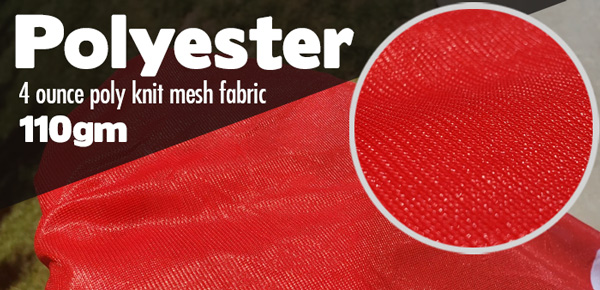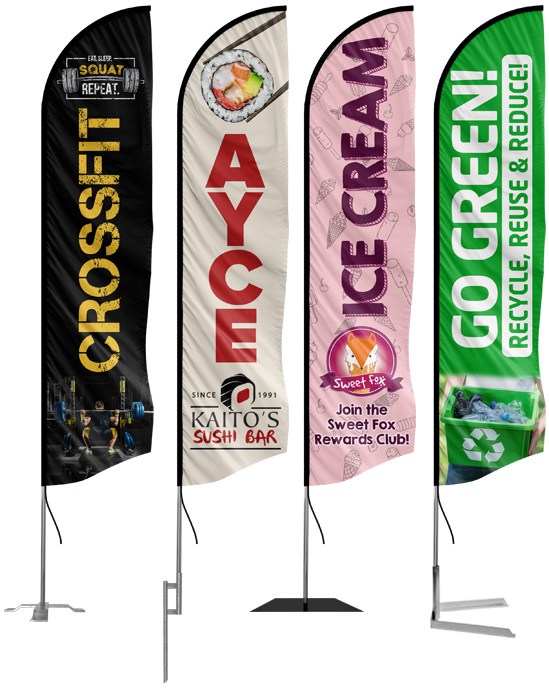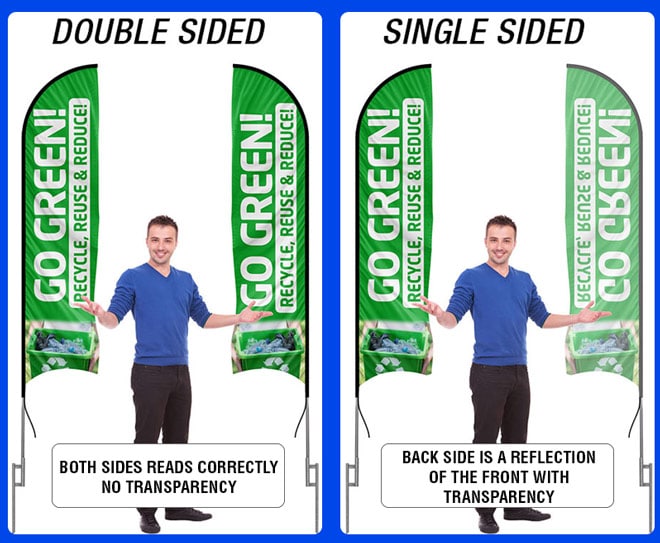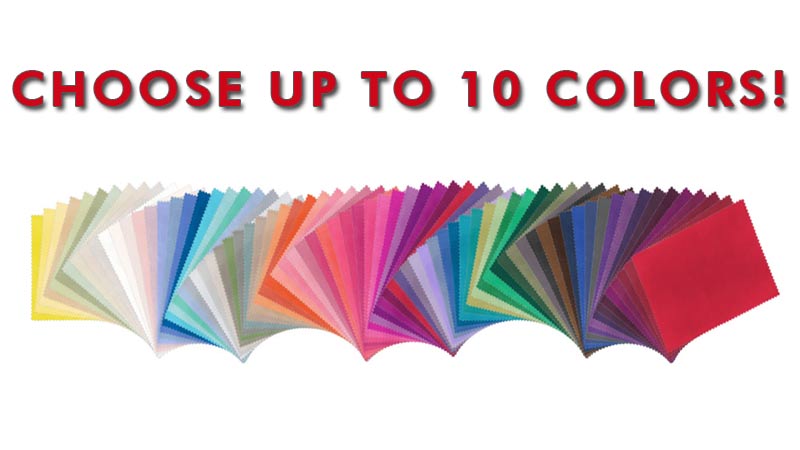What are outdoor advertising flags made from?
A question we often get at Feather Flag Nation is what are our flags made of? To start we have many types of flags: rectangle flags, standard flags, teardrop flags, garden flags, car flags, feather flags, flutter flags, and blade flags. Each flag is a little different, but they all have something in common. All our flags are made from a durable polyester blend. The polyester is a 110gm fabric, also referred to as 4 ounces poly knit mesh fabric.
Why is Polyester Better for Flags?
There is no industry standard for flags, so everyone does make them a little differently. Some companies do use nylon for their printing, but this has its limits. Nylon cannot be used for colorful printing. This is because they must be dyed using a type of acid. This means that most nylon flags are dipped into the dye or acid.
That being said, nylon does not allow for colorful or vivid colors or even image printing. Polyester on the other hand almost has no limit. This can be used to directly print onto the fabric. With this, we can print designs such as logos, words in different colors, and even high-resolution images. If you’re worried about picking polyester over nylon they share almost all the same qualities.

Both materials are:
- Lightweight
- Durable
- Synthetic
- Wrinkle-Resistant
- Stretch Resistant
- Easy Maintenance
Polyester is also faster drying, easier to dye or print, and abrasion-resistant. If you are concerned that polyester is not as soft as nylon, have no fear! Polyester has been refined in recent years to feel and in many ways match nylon. In fact, it almost resembles the softness of cotton. Polyester has strength due to the way it is made. It is made from a polymer-based construction. Polymer-based items are made from several smaller units bonded together. Since there are so many this makes it a strong material. In fact, many materials are made this way such as plastics and construction materials. Since polyester is strong it also resists pilling better than nylon. Pilling is when fabric unravels and pile up into small chunks, like on sweaters or wool. This way your flag will continue to look nice and neat.
Since our flags are meant for outdoors they will experience weather, such as rain. Polyester is faster drying than nylon, thus better suited for outdoors. The reason polyester is faster drying is that it is naturally hydrophobic. Hydrophobic means something can repel or fail to mix with water. In other words, the water will only stay on the surface of the flag and then evaporate rather than soak into the fabric. This means the flag will dry much faster!
This also means the colors bond better to the fibers of the material, while nylon absorbs water and results in dyes not bonding well. Much like how water is expelled from the fabric polyester absorbs this better. This is because it absorbs the dye while expelling the water in the dye. This is what also allows for brighter colors. This also prevents the flags from fading so fast compared to nylon. Overall polyester is better suited for outdoors because of its various properties in durability, printing, colors, and water resistance. They often outlive nylon flags.
Polyester is also an easy-care fabric. While our flags cannot be machine washed due to the heat and roughness of the machines, they can be spot cleaned.
Are Your Double-Sided Flags the Same Material?
Yes, but there is one difference. Double-sided flags are two flags sewn together (still polyester) but have a one hundred percent blackout vinyl mesh in the middle. While many companies do not insert this material we do. This is to ensure that you and your audience do not see through the flags or have any bleed through on any side. This makes it easy to read and gives it a clean look. The vinyl mesh also does not comprise the strength of the flag.
So Polyester is Better than Nylon, But What Can I Print On It?

The way we print is almost like your standard at-home printer. What we do is set a bigger piece of fabric than what you are purchasing and then have the printer print directly on it. This means we can print solid colors, logos, letters, and even high-resolution images. We say a high resolution to ensure that the image, logo, or anything else is printed clearly. Most images, such as ones taken from a cell phone are only a couple of inches big in reality. Thus when we print on a large scale, like a 12-foot flag, it does not print clearly. This is because the image is being stretched too much. On that note, if you send your logo we prefer that it is in its original format that the designer made.
This format is .ai/ or .eps/ format. A PDF also sometimes works. If you’re not sure do not worry, our design team here can check for you. This is also the same for images. It can be difficult on your own to tell if the image will print okay on a flag. We are more than happy to check for you. Just send the design team everything you have. If not we can always try and replace the image with something similar. While we can print basically anything on a flag there is one thing to keep in mind, colors do vary.
This does not mean we cannot print colors, but rather what we see on screen is different. Not only are screen colors different, but colors on textiles appear different than other materials. For example, a color printed on paper will not look exactly the same as a color on a flag. This is due to the material, but the other factor is how the technology works. Screens are in a format called RGB. This is for screens, TVs, computer monitors, cell phone screens, etc. RGB stands for red, green, and blue. These colors are then mixed together on the screen.
For that reason, we get more colors on RGB that can appear brighter or any different mix. Printers, however, do not work this way. Printers are in a format called CMYK, this stands for cyan, magenta, yellow, and black. These are the colors that mixed instead. Expect in this case the printer uses a little of each one to mix the colors. The colors also go on a scale of 0-100%. While there is a wide range there are a few limits. For example, if one color overpowers another too much it will come out differently than what is seen on screen. If a mix has a lot of magentas rather than cyan, the flag will appear more purple in color.
If you want to achieve a specific color we do offer FREE color swatches, but shipping must be covered. You can choose up to 10 swatches. If you’re not sure what colors to pick for the swatches our design team can help you. Just contact us on what color you are aiming for and we will pick an assortment.
I'm Ready to Start My Flag!
Fantastic! You can send our team a free design request here. That page allows you to write instructions on what you would like on your flag. You can be as specific as you want or just what you have an idea of. The design team will then send you a proof of the flag and go from there.
Alternatively, you can design your own flag if you have Photoshop or Illustrator using our templates here. Then you can just email the design team your artwork. We always double-check your artwork to make sure it is correct.
Have any questions? Contact Us! Send us an email at sales@featherflagnation.com or give us a call at 1 (877) 900-5692. We are open M-F from 8am-4:30pm PST
REQUEST A DESIGN NOW & GET FREE SHIPPING




